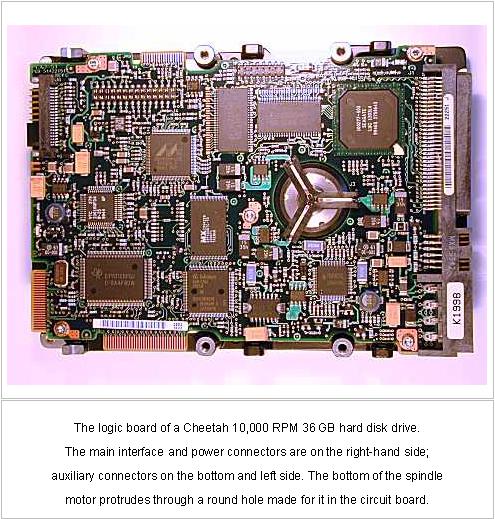
PCBA, control circuitry (Printed Circuit Board Assembly)
All modern hard disks are made with an intelligent circuit board integrated into the hard disk unit. Early hard disks were virtually all of the control logic for controlling the hard disk itself was placed into the controller plugged into the PC; there were little smarts on the drive itself, which had to be told specifically how to perform every action.
As newer drives were introduced with more features and faster speed, this approach became quite impractical, and once electronics miniaturization progressed far enough, it made sense to move most of the control functions to the drive itself.
The most common interface for PC hard disks is called IDE, which in fact stands for Integrated Drive Electronics. This name is something of a misnomer today. When it was introduced, IDE was distinguished from the other interfaces of the day by having the integrated electronics on the drive, instead of on the controller card plugged into the system bus like older interfaces. However, the term really refers to where the control logic is and not the interface itself, and since all hard disks today use integrated electronics the name doesn’t mean anything any more, despite the fact that everyone continues to use it. The other popular PC hard disk interface today, SCSI, also uses drives that have integrated controllers. The more correct name for the IDE interface is AT Attachment or ATA.
The logic board of a Cheetah 10,000 RPM 36 GB hard disk drive.The main interface and power connectors are on the right-hand side;auxiliary connectors on the bottom and left side. The bottom of the spindlemotor protrudes through a round hole made for it in the circuit board.
What’s the relationship between PCBA and Control Circuitry? Let me give an example. The electric current is like Blood and the Control Circuitry is like the blood vessel distributing on the HDD, and the PCBA is like the brain to process and give orders to particular parts.
The drive’s internal logic board contains a microprocessor (inside main chip) and internal memory (RAM chip), and other structures and circuits that control what happens inside the drive.
In many ways, this is like a small embedded PC within the hard disk itself. The control circuitry of the drive performs the following functions (among others):
1. Controlling the spindle motor, including making sure the spindle runs at the correct speed.
2. Controlling the actuator’s movement to various tracks.
3. Managing all read/write operations.
4. Implementing power management features.
5. Handling geometry translation.
6. Managing the internal cache and optimization features such as pre-fetch.
7. Coordinating and integrating the other functions, such as the flow of information over the hard disk interface, optimizing multiple requests, converting data to and from the form the read/write heads require it, etc.
8. Implementing all advanced performance and reliability features.
You may think that the Control Circuitry is not so important. The reason is that the quality or optimization level of the control circuitry doesn’t manifest itself as a single, simple specification. You can’t easily compare the circuitry of five different drive families. Most hard disk manufacturers provide very little information about the “guts” of the logic board, and even if they did, most people wouldn’t know what to do with the information.
However, the control circuitry of the drive is underrated and misunderstood, even by those interested in hard disk performance issues.
In fact, differences in control circuitry account for part of the differences in some specifications. This is probably most true of seek performance, Beyond this, you can’t really tell much about what’s inside the circuitry. However, if you use two different drives that have very similar specifications and run on the same interface on the same PC, but one just “feels faster” than the other, differences in their internal circuitry may be part of the answer.

